Addressing the Effects of Climate Change on Modeling Future Hydroelectric Energy Production in Chile
Abstract
1. Introduction
2. Modeling of Hydrological Uncertainty in Electricity Markets
3. Modeling of Hydrological Uncertainty in the Chilean Electricity Market
3.1. Treatment of Hydro-Uncertainty in Chilean Electricity Market Models
3.2. Analysis of Historical Hydro-Energy Inflows Data
3.3. Climate Forcings and Their Impact on Chilean Hydrological Conditions
4. Criteria for the Selection of an Alternative Range of Hydro-Years
4.1. Methodological Alternatives
4.2. Criteria Definition
5. Analysis of Reduced Subsets of Different Sizes
5.1. Analysis of the Mean Hydro-Inflows
5.2. Analysis of the Variability of the Hydro Inflows
6. Discussion of Results and Conclusions
Author Contributions
Funding
Institutional Review Board Statement
Informed Consent Statement
Data Availability Statement
Acknowledgments
Conflicts of Interest
Abbreviations
| ACF | Anthropogenic Climate Forcing |
| CEN | Independent System Coordinator (Coordinador Eléctrico Nacional |
| CEPAL | United Nations Economic Commission for Latin America and the Caribbean (Comisión Económica para América Latina y el Caribe) |
| CNE | National Energy Commission (Comisión Nacional de Energía) |
| ENSO | El Niño-Southern Oscillation |
| GCM | General Circulation Model |
| GHG | Greenhouse gas emissions |
| GWh | Gigawatt-hour |
| IPCC | The Intergovernmental Panel on Climate Change |
| MD | Mega-drought |
| PDO | Pacific Decadal Oscillation |
| SAM | Southern Annular Mode |
| SEN | Chilean interconnected system (Sistema Eléctrico Nacional) |
| SDDP | Stochastic Dual Dynamic Programming |
| WMO | World Meteorological Organization |
References
- IPCC. Climate change 2014: Synthesis report. In Contribution of Working Groups I, II and III to the Fifth Assessment Report of the Intergovernmental Panel on Climate Change; Pachauri, R., Meyer, L., Eds.; IPCC: Geneva, Switzerland, 2014. [Google Scholar]
- Seneviratne, S.; Nicholls, N.; Easterling, D.; Goodess, C.; Kanae, S.; Kossin, J.; Luo, Y.; Marengo, J.; McInnes, K.; Rahimi, M.; et al. Changes in climate extremes and their impacts on the natural physical environment. In Managing the Risks of Extreme Events and Disasters to Advance Climate Change Adaptation. A Special Report of Working Groups I and II of the Intergovernmental Panel on Climate Change (IPCC); Field, C., Barros, V., Stocker, T., Qin, D., Dokken, D., Ebi, K., Mastrandrea, M., Mach, K., Plattner, G.K., Allen, S., et al., Eds.; Cambridge University Press: Cambridge, UK; New York, NY, USA, 2012; Chapter 3; pp. 109–230. [Google Scholar]
- Trenberth, K.E. Changes in precipitation with climate change. Clim. Res. 2011, 47, 123–138. [Google Scholar] [CrossRef]
- Sun, Y.; Solomon, S.; Dai, A.; Portmann, R.W. How often will it rain? J. Clim. 2007, 20, 4801–4818. [Google Scholar] [CrossRef]
- Dai, A.; Zhao, T.; Chen, J. Climate change and drought: A precipitation and evaporation perspective. Curr. Clim. Chang. Rep. 2018, 4, 301–312. [Google Scholar] [CrossRef]
- Dai, A.; Rasmussen, R.M.; Liu, C.; Ikeda, K.; Prein, A.F. A new mechanism for warm-season precipitation response to global warming based on convection-permitting simulations. Clim. Dyn. 2020, 55, 343–368. [Google Scholar] [CrossRef]
- Forrest, K.; Tarroja, B.; Chiang, F.; AghaKouchak, A.; Samuelsen, S. Assessing climate change impacts on California hydropower generation and ancillary services provision. Clim. Chang. 2018, 151, 395–412. [Google Scholar] [CrossRef]
- Ehsani, N.; Vörösmarty, C.J.; Fekete, B.M.; Stakhiv, E.Z. Impact of a Warming Climate on Hydropower in the Northeast United States: The Untapped Potential of Non-Powered Dams. Preprints 2017, 2017110116. [Google Scholar] [CrossRef]
- Shevnina, E.; Pilli-Sihvola, K.; Haavisto, R.; Vihma, T.; Silaev, A. Climate change will increase potential hydropower production in six Arctic Council member countries based on probabilistic hydrological projections. Hydrol. Earth Syst. Sci. 2018. [Google Scholar] [CrossRef]
- Uamusse, M.M.; Aljaradin, M.; Nilsson, E.; Persson, K.M. Climate change observations into hydropower in Mozambique. Energy Procedia 2017, 138, 592–597. [Google Scholar] [CrossRef]
- Machina, M.B.; Sharma, S. Assessment of climate change impact on hydropower generation: A case study of Nigeria. Int. J. Eng. Technol. Sci. Res. 2017, 4, 753–762. [Google Scholar]
- Boadi, S.A.; Owusu, K. Impact of climate change and variability on hydropower in Ghana. Afr. Geogr. Rev. 2019, 38, 19–31. [Google Scholar] [CrossRef]
- Zhang, Y.; Gu, A.; Lu, H.; Wang, W. Hydropower generation vulnerability in the Yangtze River in China under climate change scenarios: Analysis based on the WEAP model. Sustainability 2017, 9, 2085. [Google Scholar] [CrossRef]
- Wang, H.; Xiao, W.; Wang, Y.; Zhao, Y.; Lu, F.; Yang, M.; Hou, B.; Yang, H. Assessment of the impact of climate change on hydropower potential in the Nanliujiang river basin of China. Energy 2019, 167, 950–959. [Google Scholar] [CrossRef]
- Liu, X.; Tang, Q.; Voisin, N.; Cui, H. Projected impacts of climate change on hydropower potential in China. Hydrol. Earth Syst. Sci. 2016, 20, 3343–3359. [Google Scholar] [CrossRef]
- Fan, J.L.; Hu, J.W.; Zhang, X.; Kong, L.S.; Li, F.; Mi, Z. Impacts of climate change on hydropower generation in China. Math. Comput. Simul. 2020, 167, 4–18. [Google Scholar] [CrossRef]
- Khaniya, B.; Priyantha, H.G.; Baduge, N.; Azamathulla, H.M.; Rathnayake, U. Impact of climate variability on hydropower generation: A case study from Sri Lanka. ISH J. Hydraul. Eng. 2020, 26, 301–309. [Google Scholar] [CrossRef]
- Shrestha, A.; Shrestha, S.; Tingsanchali, T.; Budhathoki, A.; Ninsawat, S. Adapting hydropower production to climate change: A case study of Kulekhani Hydropower Project in Nepal. J. Clean. Prod. 2020, 279, 123483. [Google Scholar] [CrossRef]
- Ali, S.A.; Aadhar, S.; Shah, H.L.; Mishra, V. Projected increase in hydropower production in India under climate change. Sci. Rep. 2018, 8, 1–12. [Google Scholar] [CrossRef]
- Caruso, B.; King, R.; Newton, S.; Zammit, C. Simulation of climate change effects on hydropower operations in mountain headwater lakes, New Zealand. River Res. Appl. 2017, 33, 147–161. [Google Scholar] [CrossRef]
- Teotónio, C.; Fortes, P.; Roebeling, P.; Rodriguez, M.; Robaina-Alves, M. Assessing the impacts of climate change on hydropower generation and the power sector in Portugal: A partial equilibrium approach. Renew. Sustain. Energy Rev. 2017, 74, 788–799. [Google Scholar] [CrossRef]
- Majone, B.; Villa, F.; Deidda, R.; Bellin, A. Impact of climate change and water use policies on hydropower potential in the south-eastern Alpine region. Sci. Total Environ. 2016, 543, 965–980. [Google Scholar] [CrossRef]
- Bombelli, G.M.; Soncini, A.; Bianchi, A.; Bocchiola, D. Potentially modified hydropower production under climate change in the Italian Alps. Hydrol. Process. 2019, 33, 2355–2372. [Google Scholar] [CrossRef]
- Savelsberg, J.; Schillinger, M.; Schlecht, I.; Weigt, H. The impact of climate change on Swiss hydropower. Sustainability 2018, 10, 2541. [Google Scholar] [CrossRef]
- Ritesh Patro, E.; Gaudard, L.; De Michele, C. Hydropower revenues under the threat of climate change: Case studies from Europe. Geophys. Res. Abstr. 2019, 21, EGU2019-320-1. [Google Scholar]
- de Queiroz, A.R.; Lima, L.M.M.; Lima, J.W.M.; da Silva, B.C.; Scianni, L.A. Climate change impacts in the energy supply of the Brazilian hydro-dominant power system. Renew. Energy 2016, 99, 379–389. [Google Scholar] [CrossRef]
- de Oliveira, V.A.; de Mello, C.R.; Viola, M.R.; Srinivasan, R. Assessment of climate change impacts on streamflow and hydropower potential in the headwater region of the Grande river basin, Southeastern Brazil. Int. J. Climatol. 2017, 37, 5005–5023. [Google Scholar] [CrossRef]
- de Souza Dias, V.; Pereira da Luz, M.; Medero, G.M.; Tarley Ferreira Nascimento, D. An overview of hydropower reservoirs in Brazil: Current situation, future perspectives and impacts of climate change. Water 2018, 10, 592. [Google Scholar] [CrossRef]
- de Queiroz, A.R.; Faria, V.A.; Lima, L.M.; Lima, J.W. Hydropower revenues under the threat of climate change in Brazil. Renew. Energy 2019, 133, 873–882. [Google Scholar] [CrossRef]
- Hasan, M.M.; Wyseure, G. Impact of climate change on hydropower generation in Rio Jubones Basin, Ecuador. Water Sci. Eng. 2018, 11, 157–166. [Google Scholar] [CrossRef]
- Arriagada, P.; Dieppois, B.; Sidibe, M.; Link, O. Impacts of climate change and climate variability on hydropower potential in data-scarce regions subjected to multi-decadal variability. Energies 2019, 12, 2747. [Google Scholar] [CrossRef]
- Oyerinde, G.T.; Wisser, D.; Hountondji, F.C.; Odofin, A.J.; Lawin, A.E.; Afouda, A.; Diekkrüger, B. Quantifying uncertainties in modeling climate change impacts on hydropower production. Climate 2016, 4, 34. [Google Scholar] [CrossRef]
- Wen, X.; Liu, Z.; Lei, X.; Lin, R.; Fang, G.; Tan, Q.; Wang, C.; Tian, Y.; Quan, J. Future changes in Yuan River ecohydrology: Individual and cumulative impacts of climates change and cascade hydropower development on runoff and aquatic habitat quality. Sci. Total Environ. 2018, 633, 1403–1417. [Google Scholar] [CrossRef] [PubMed]
- Guerra, O.J.; Tejada, D.A.; Reklaitis, G.V. Climate change impacts and adaptation strategies for a hydro-dominated power system via stochastic optimization. Appl. Energy 2019, 233, 584–598. [Google Scholar] [CrossRef]
- Feng, Y.; Zhou, J.; Mo, L.; Yuan, Z.; Zhang, P.; Wu, J.; Wang, C.; Wang, Y. Long-term hydropower generation of cascade reservoirs under future climate changes in Jinsha River in Southwest China. Water 2018, 10, 235. [Google Scholar] [CrossRef]
- François, B.; Hingray, B.; Borga, M.; Zoccatelli, D.; Brown, C.; Creutin, J.D. Impact of climate change on combined solar and run-of-river power in northern Italy. Energies 2018, 11, 290. [Google Scholar] [CrossRef]
- Pilesjo, P.; Al-Juboori, S.S. Modelling the effects of climate change on hydroelectric power in Dokan, Iraq. Int. J. Energy Power Eng. 2016, 5, 7. [Google Scholar] [CrossRef]
- Miao, C.; Su, L.; Sun, Q.; Duan, Q. A nonstationary bias-correction technique to remove bias in GCM simulations. J. Geophys. Res. Atmos. 2016, 121, 5718–5735. [Google Scholar] [CrossRef]
- Pereira, M.V.; Pinto, L.M. Multi-stage stochastic optimization applied to energy planning. Math. Program. 1991, 52, 359–375. [Google Scholar] [CrossRef]
- Gjerden, K.S.; Helseth, A.; Mo, B.; Warland, G. Hydrothermal scheduling in Norway using stochastic dual dynamic programming; a large-scale case study. In Proceedings of the 2015 IEEE Eindhoven PowerTech, Eindhoven, The Netherlands, 29 June–2 July 2015; pp. 1–6. [Google Scholar] [CrossRef]
- CNE. Fijación de precios de nudo de corto plazo: Informe Técnico Definitivo; Technical Report; Comisión Nacional de Energía: Santiago, Chile, 2020. [Google Scholar]
- Dictuc. Análisis de la estadística hidrológica empleada para la estimación del precio de nudo del SIC; Technical Report; Dictuc: Santiago, Chile, 1999. [Google Scholar]
- Boisier, J.P.; Rondanelli, R.; Garreaud, R.D.; Muñoz, F. Anthropogenic and natural contributions to the Southeast Pacific precipitation decline and recent megadrought in central Chile. Geophys. Res. Lett. 2016, 43, 413–421. [Google Scholar] [CrossRef]
- Bozkurt, D.; Rojas, M.; Boisier, J.P.; Valdivieso, J. Climate change impacts on hydroclimatic regimes and extremes over Andean basins in central Chile. Hydrol. Earth Syst. Sci. Discuss 2017, 2017, 1–29. [Google Scholar]
- Bozkurt, D.; Rojas, M.; Boisier, J.P.; Valdivieso, J. Projected hydroclimate changes over Andean basins in central Chile from downscaled CMIP5 models under the low and high emission scenarios. Clim. Chang. 2018, 150, 131–147. [Google Scholar] [CrossRef]
- McPhee, J. Análisis de la vulnerabilidad del sector hidroeléctrico frente a escenarios futuros de cambio climático en Chile; Technical Report; UN-CEPAL: Santiago, Chile, 2012. [Google Scholar]
- Garreaud, R.D.; Boisier, J.P.; Rondanelli, R.; Montecinos, A.; Sepúlveda, H.H.; Veloso-Aguila, D. The central Chile mega drought (2010–2018): A climate dynamics perspective. Int. J. Climatol. 2020, 40, 421–439. [Google Scholar] [CrossRef]
- CR2. La megasequía 2010–2015: Una lección para el futuro; Technical Report; Centro de Ciencia del Clima y la Resiliencia (CR)2: Santiago, Chile, 2015. [Google Scholar]
- DGA. Balance Hídrico de Chile; Technical Report; Dirección General de Aguas: Santiago, Chile, 2019. [Google Scholar]
- Garreaud, R.D.; Alvarez-Garreton, C.; Barichivich, J.; Boisier, J.P.; Christie, D.; Galleguillos, M.; LeQuesne, C.; McPhee, J.; Zambrano-Bigiarini, M. The 2010–2015 megadrought in central Chile: Impacts on regional hydroclimate and vegetation. Hydrol. Earth Syst. Sci. 2017, 21, 6307–6327. [Google Scholar] [CrossRef]
- Morales, Y.; Olivares, M.; Vargas, X. Improving the flow representation in a stochastic programming model for hydropower operations in Chile. In Proceedings of the American Geophysical Union, Fall Meeting, San Francisco, CA, USA, 14–18 December 2015. [Google Scholar]
- Aravena, I.; Gil, E. Hydrological scenario reduction for stochastic optimization in hydrothermal power systems. Appl. Stoch. Models Bus. Ind. 2015, 31, 231–240. [Google Scholar] [CrossRef]
- IPCC. Annex III. Glossary: IPCC—Intergovernmental Panel on Climate Change; Planton, S., Ed.; IPCC Fifth Assessment Report; IPCC: Geneva, Switzerland, 2013; p. 1450.
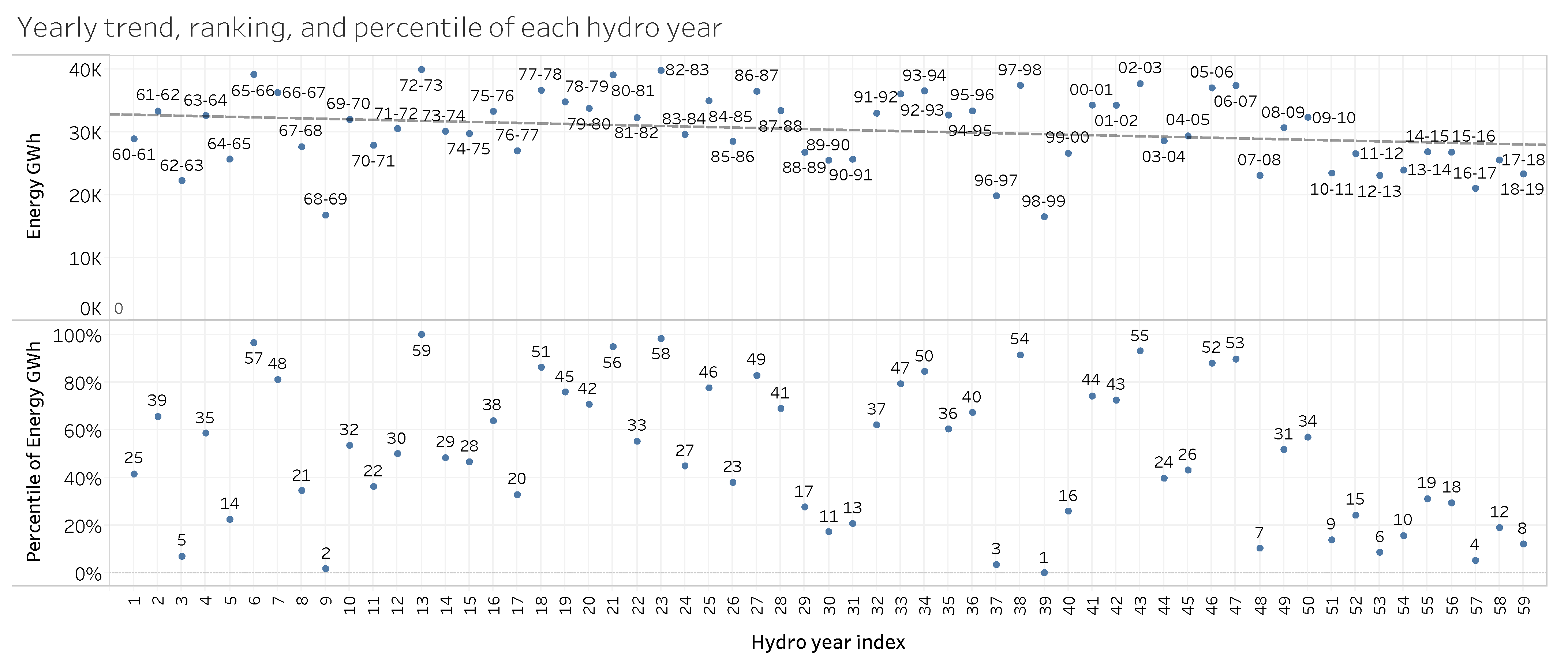
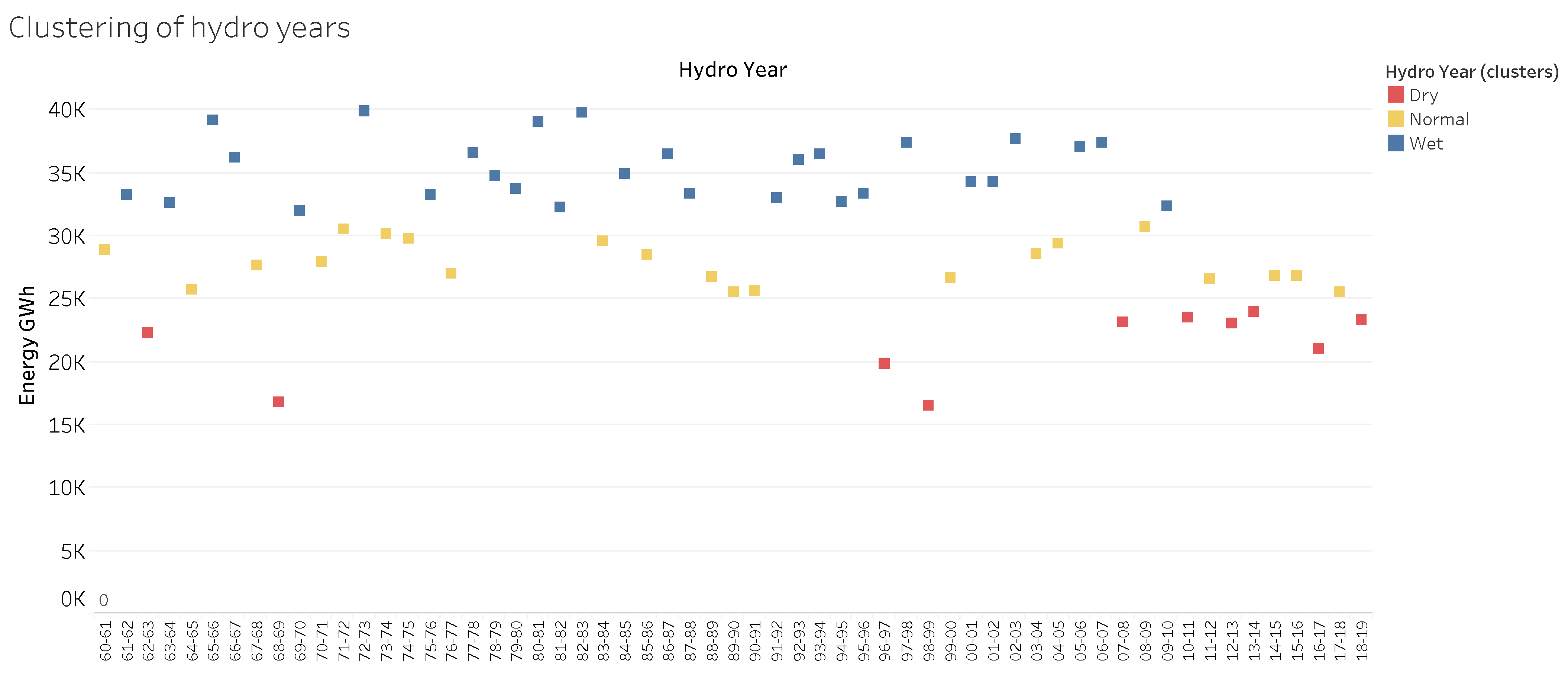
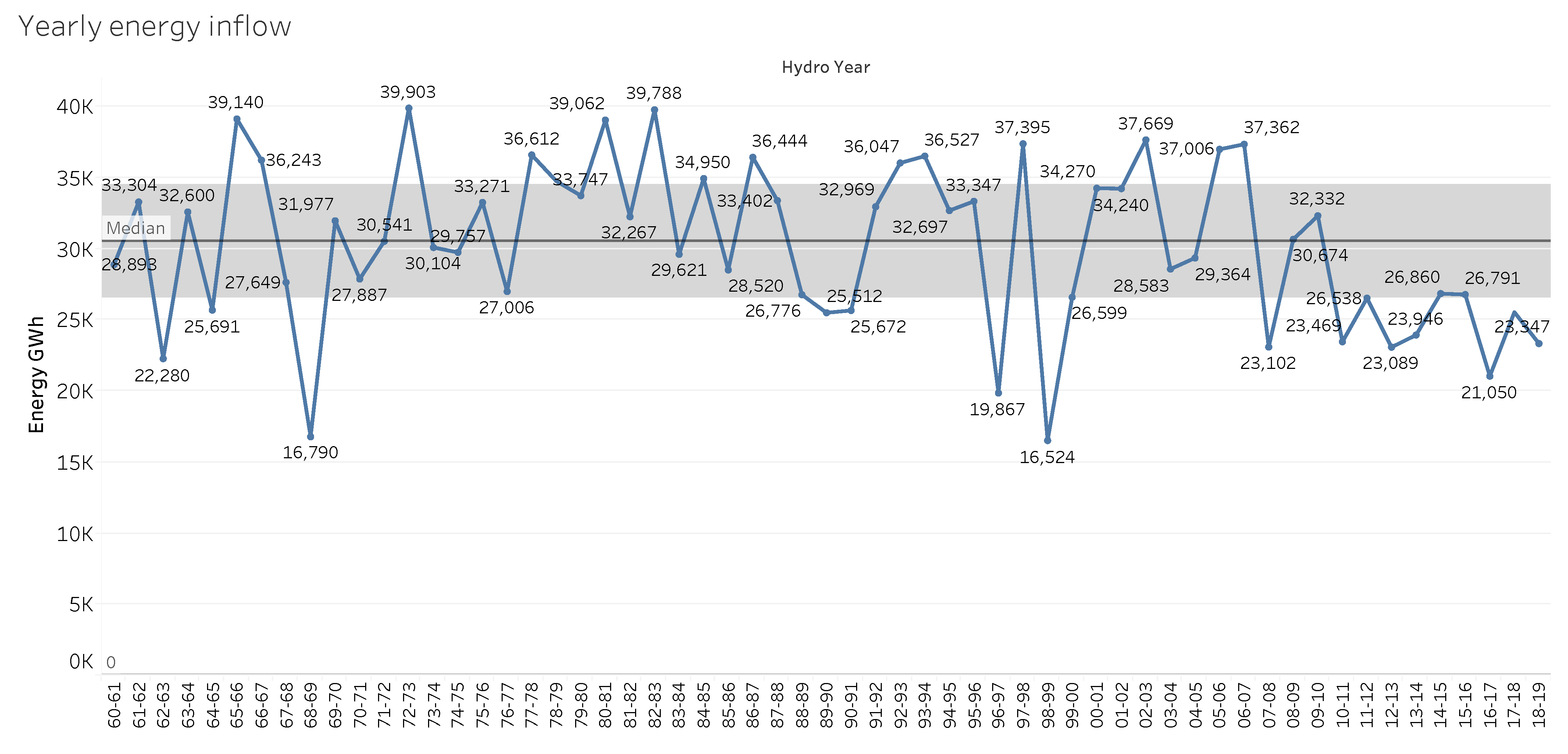
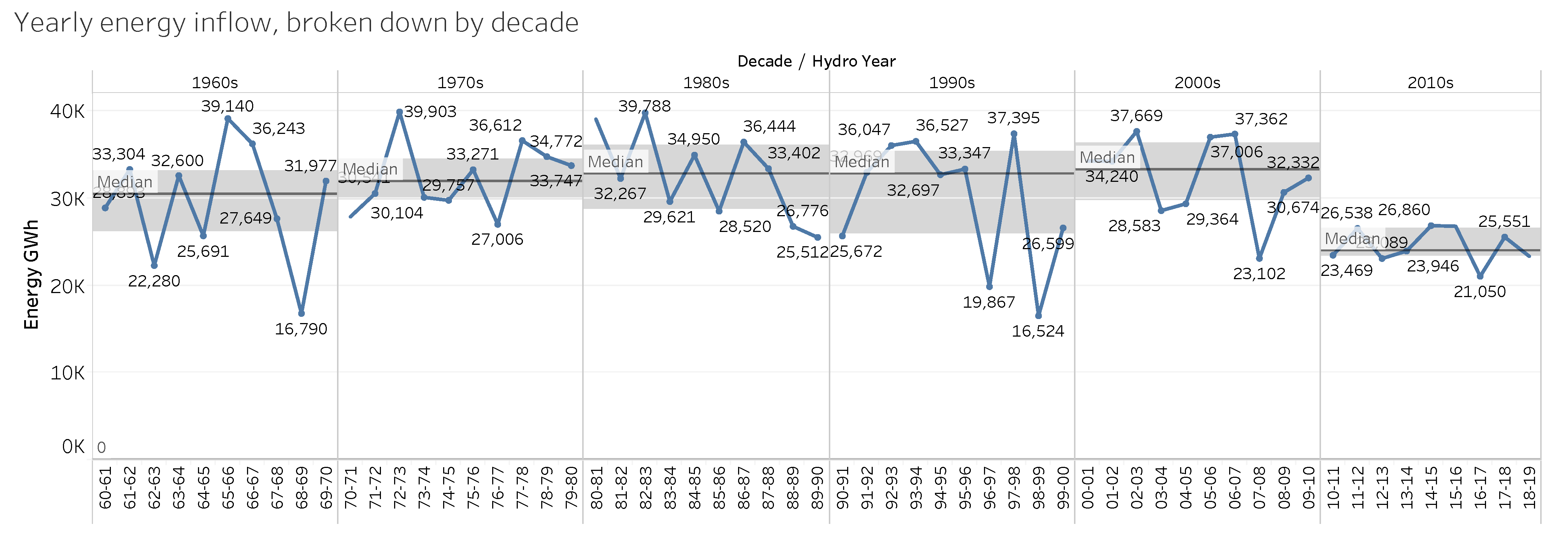
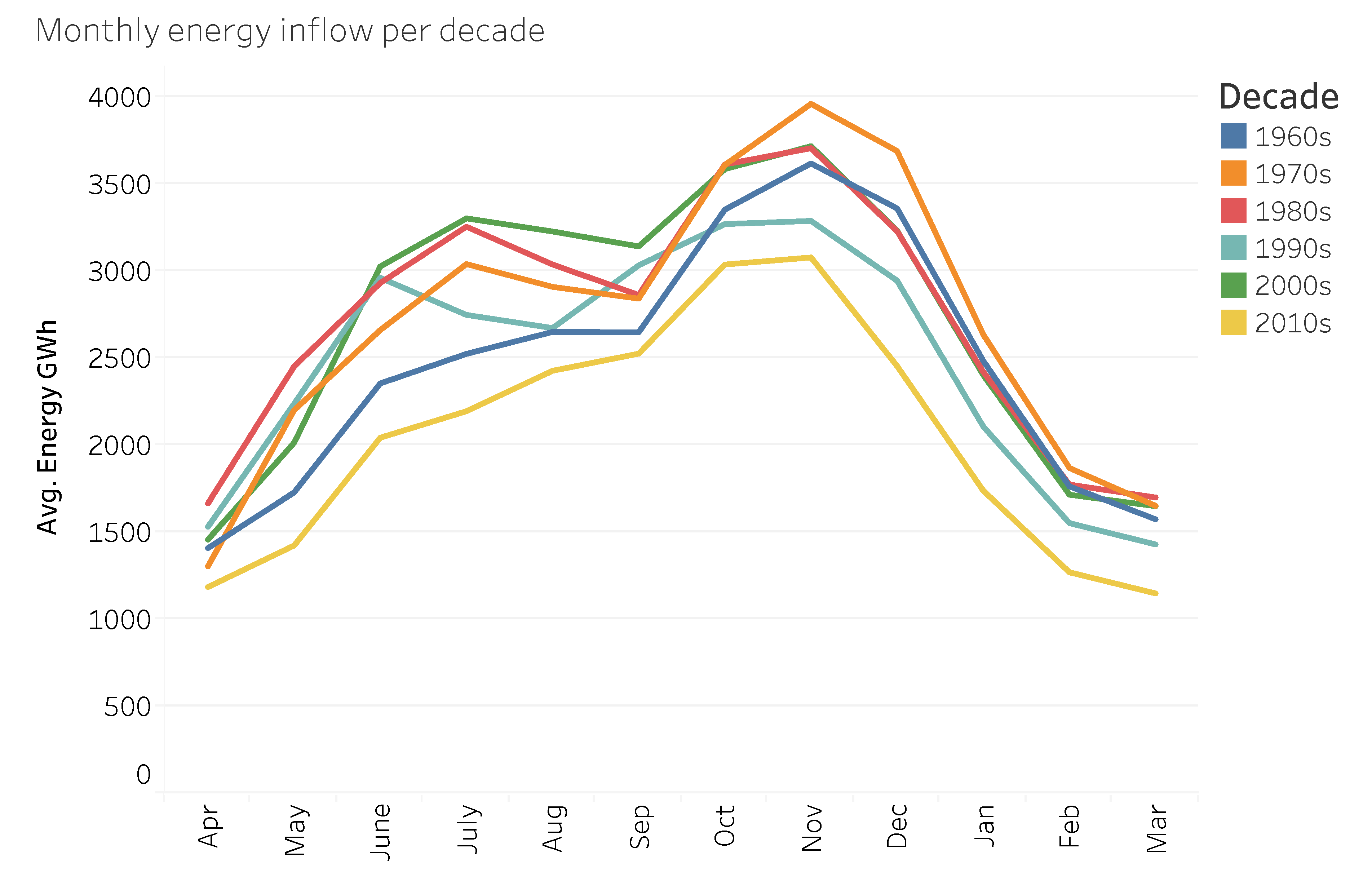
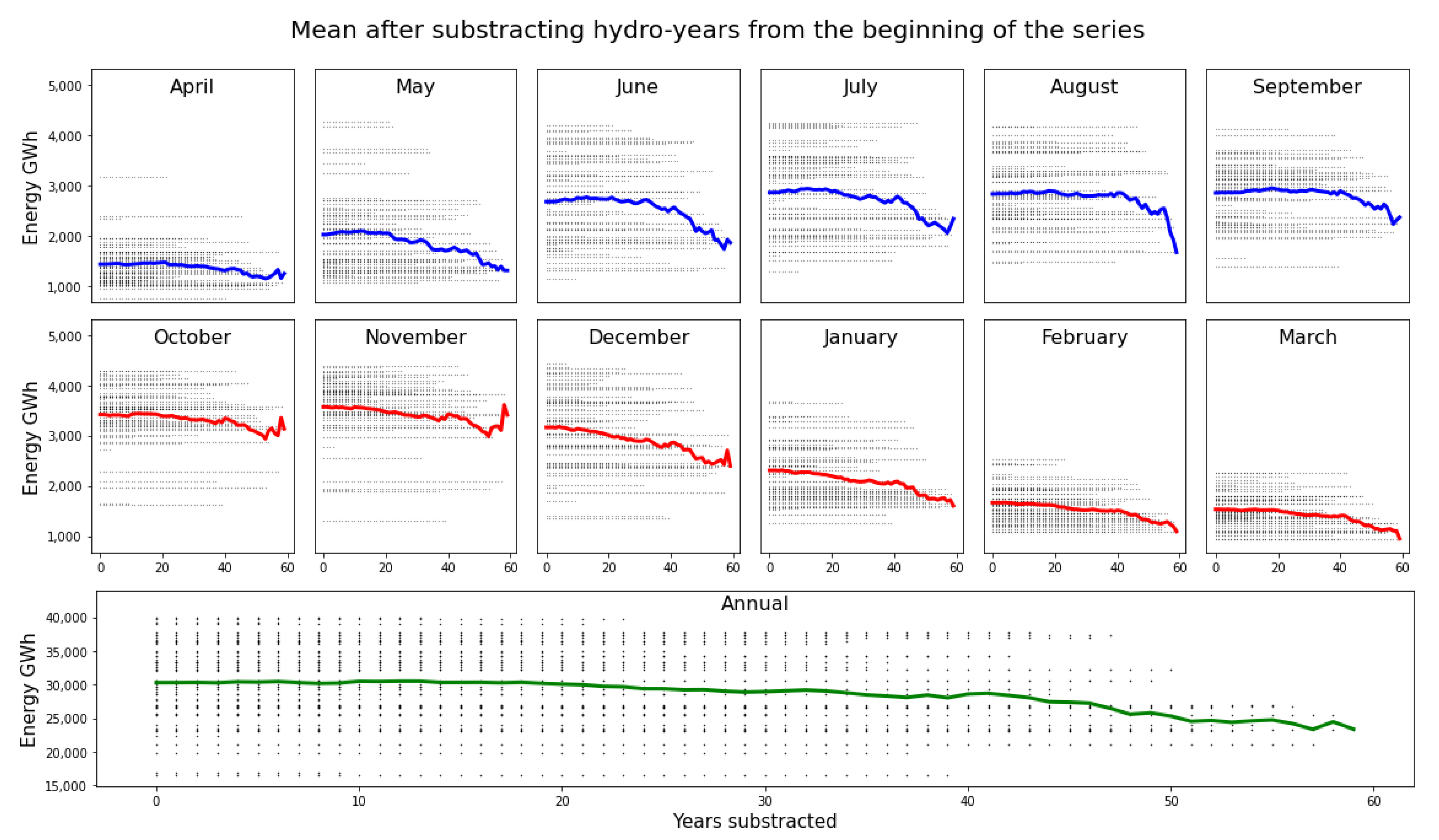
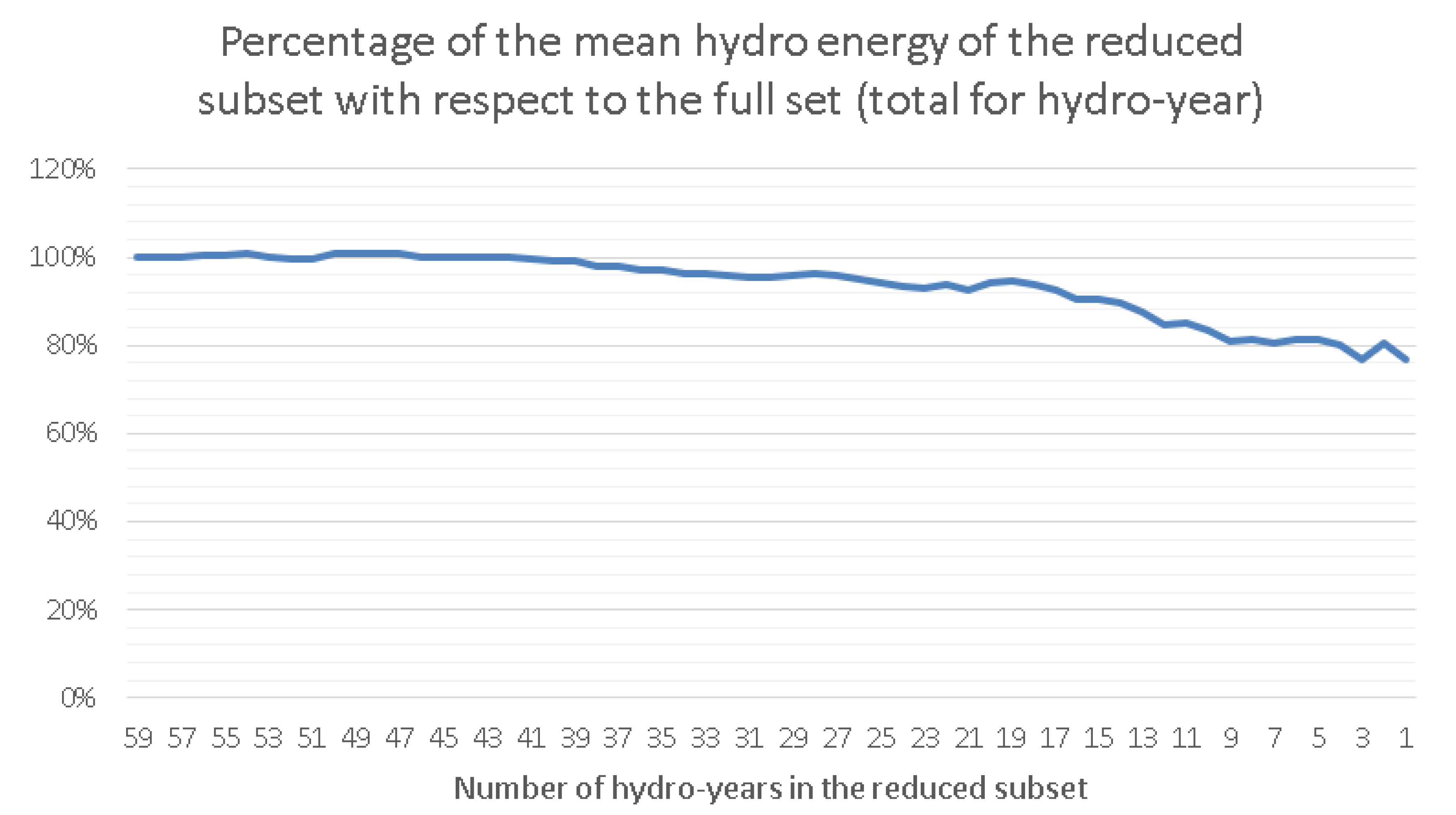
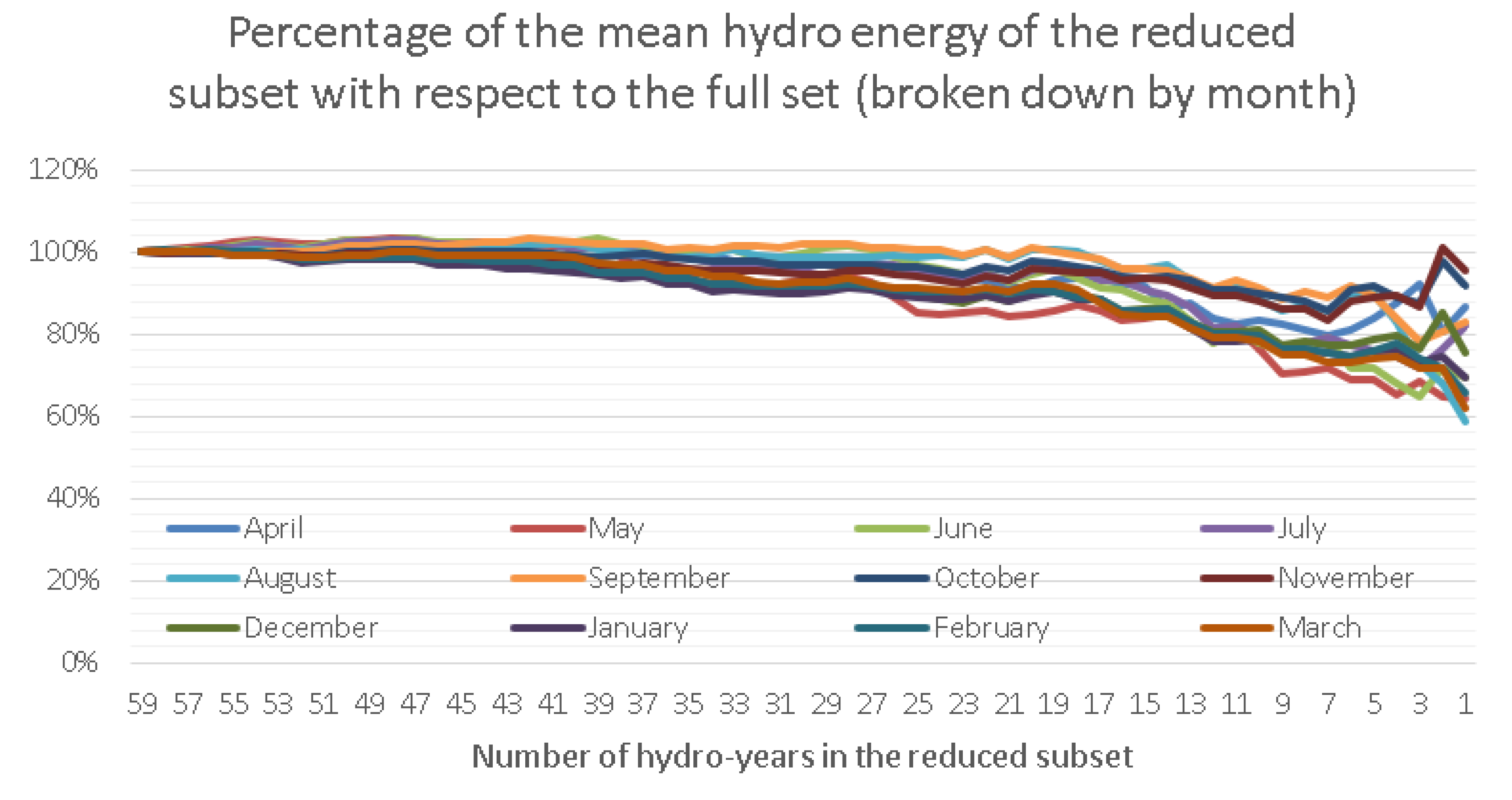
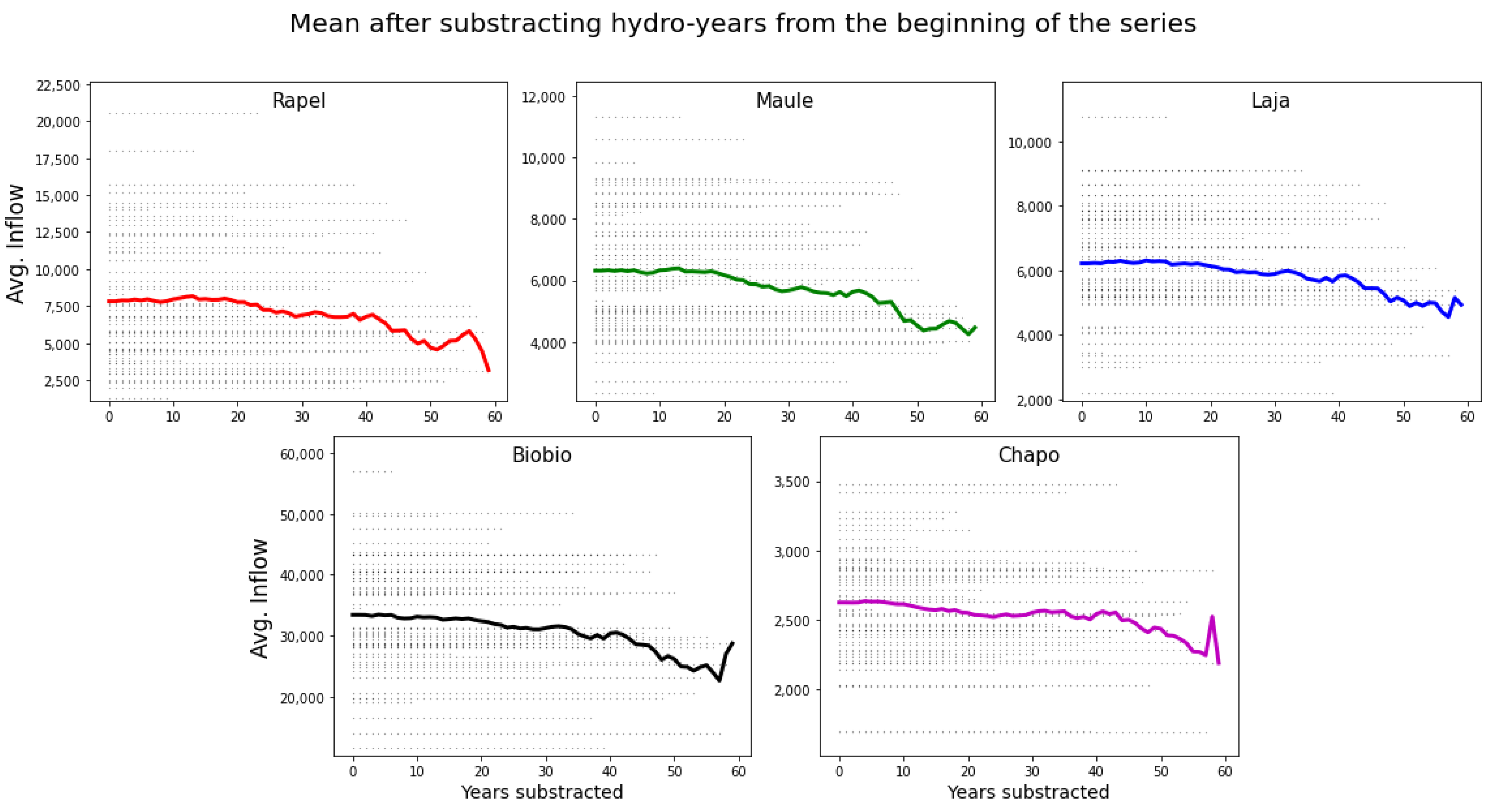
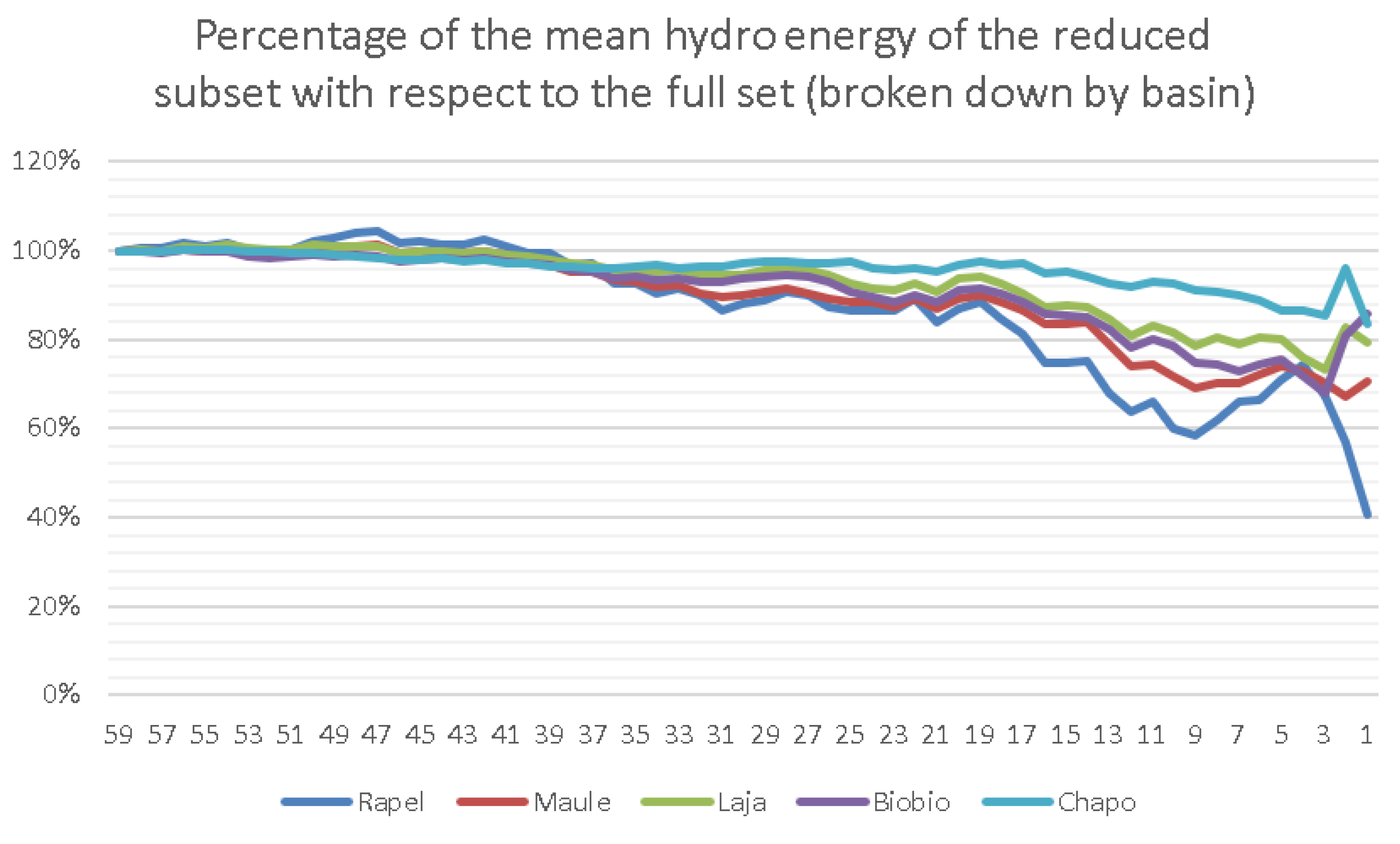
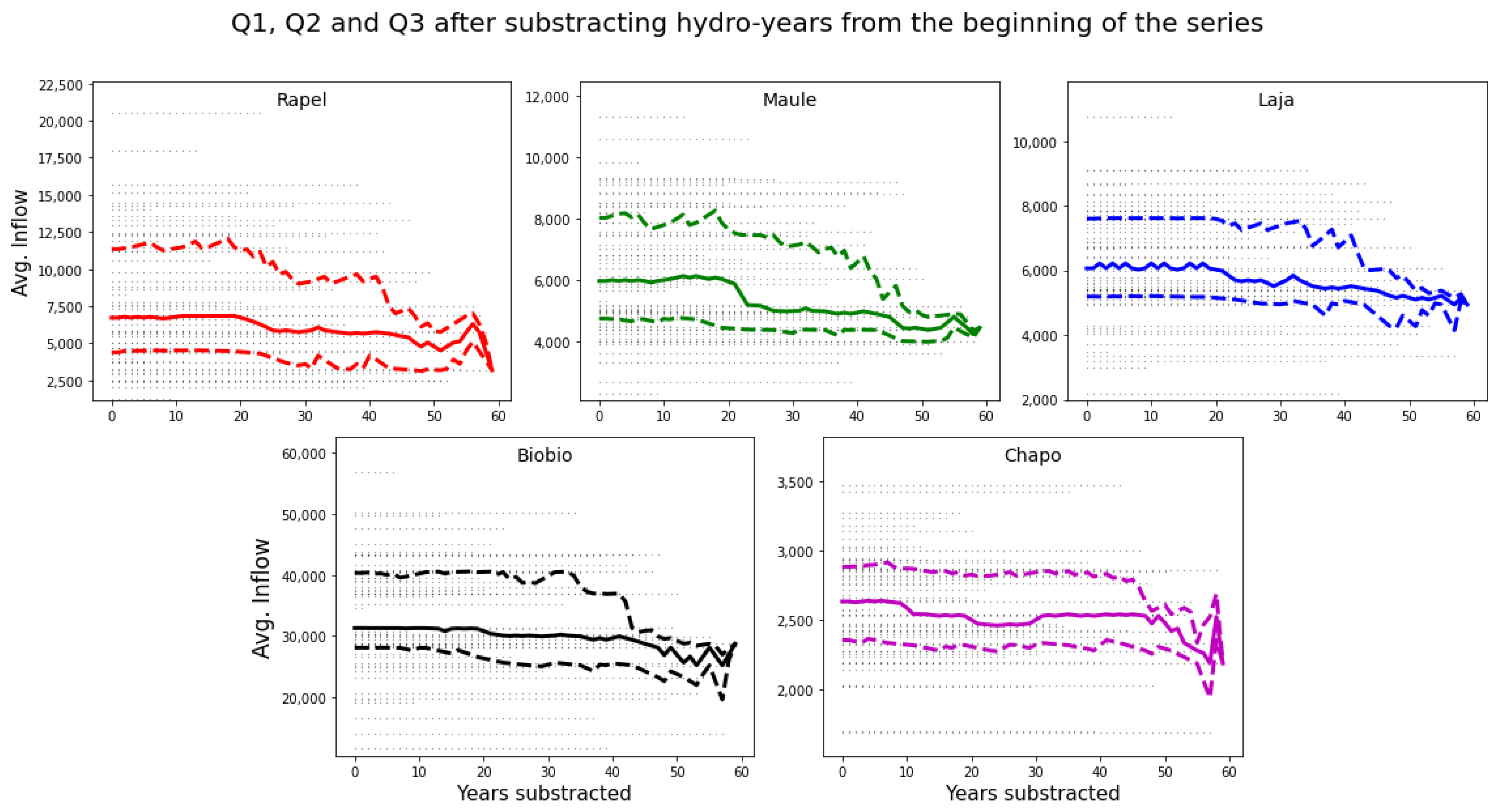
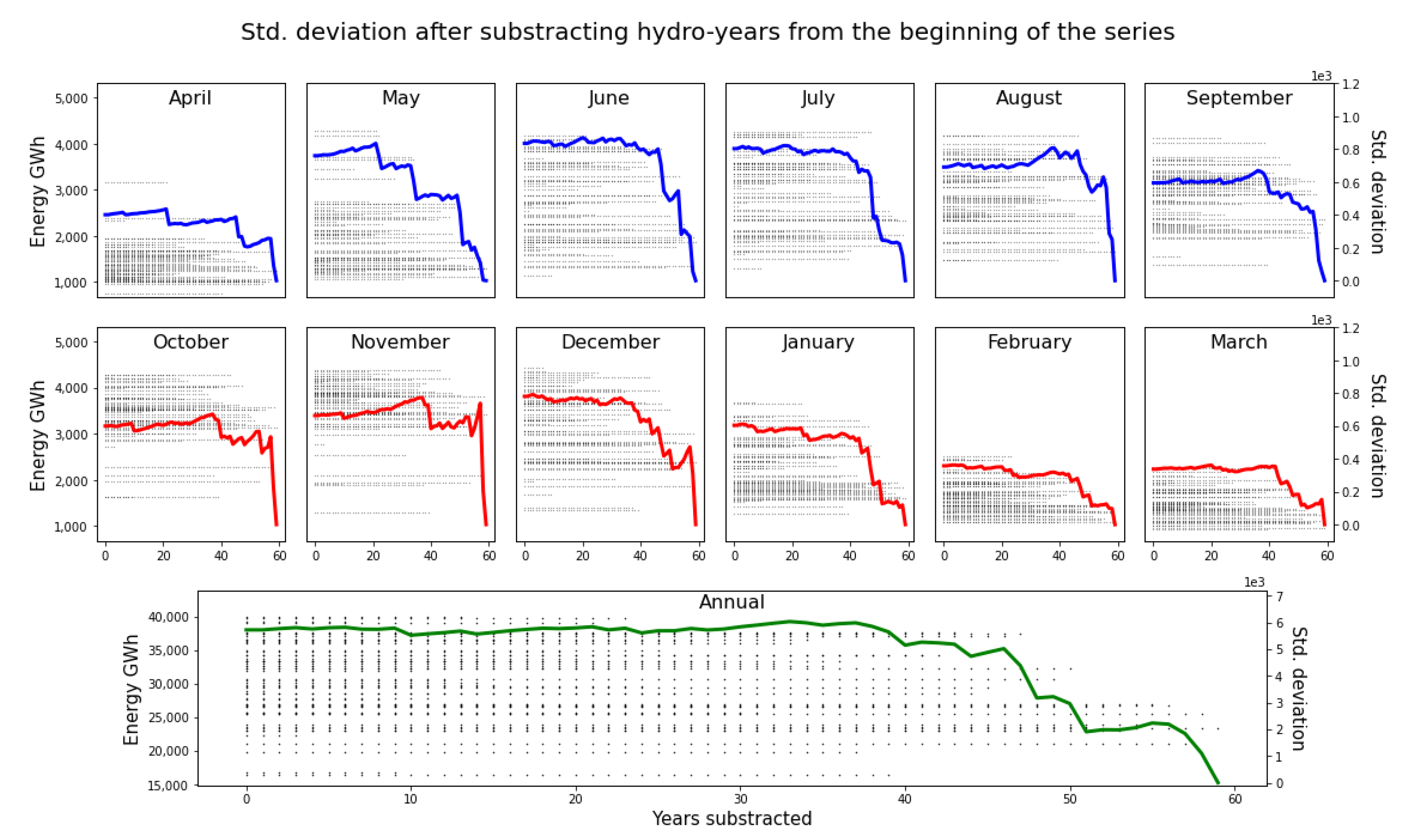
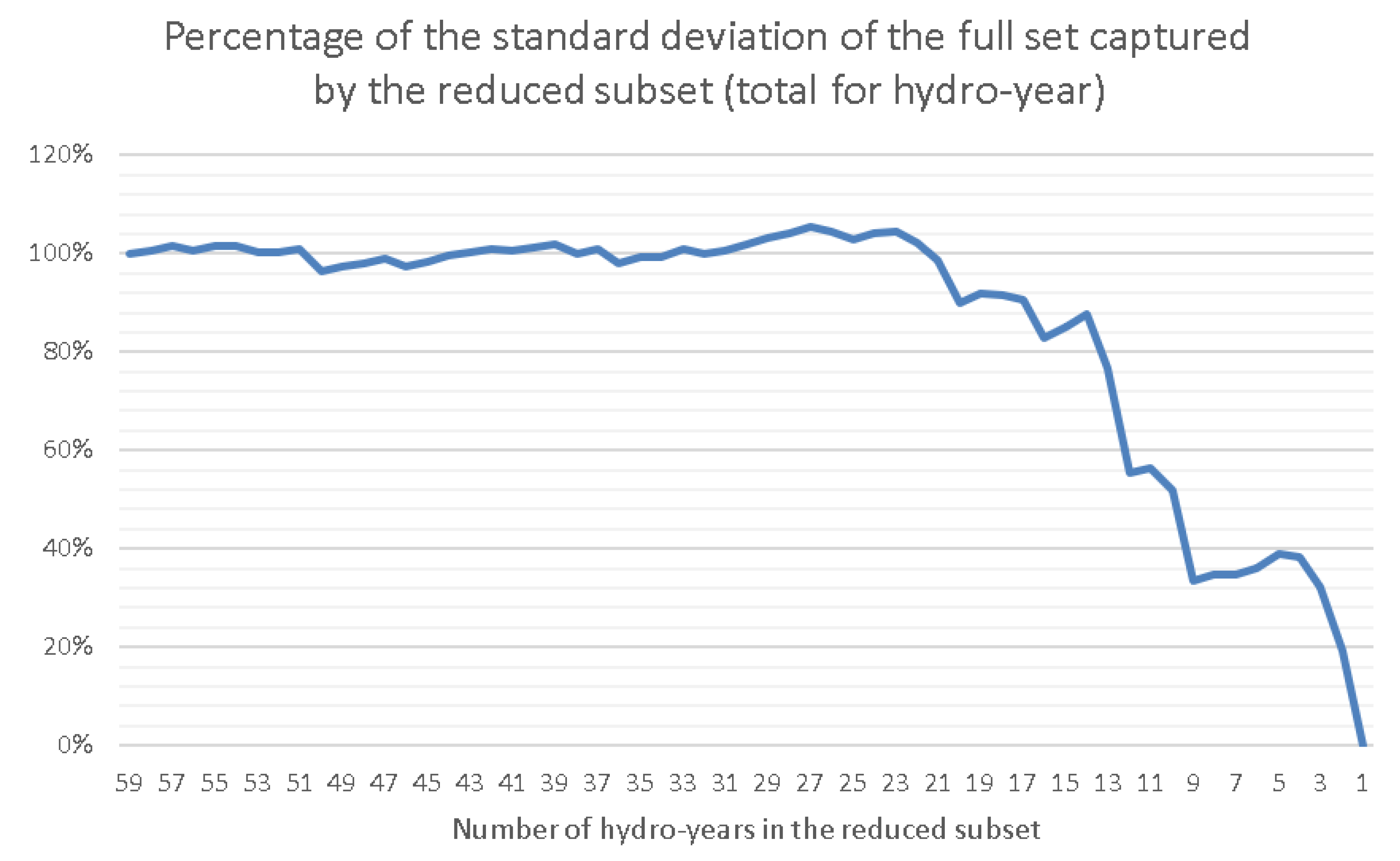
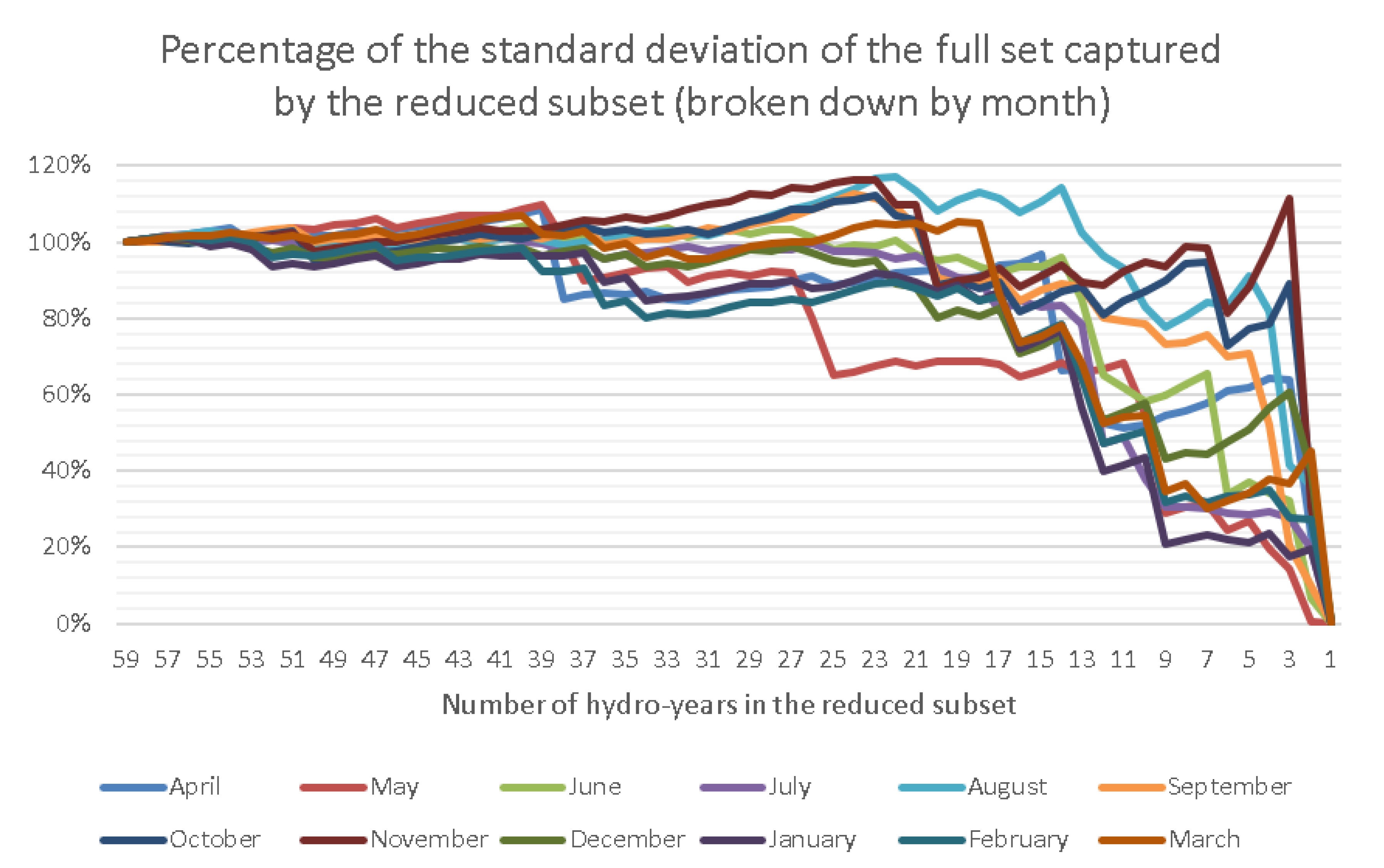
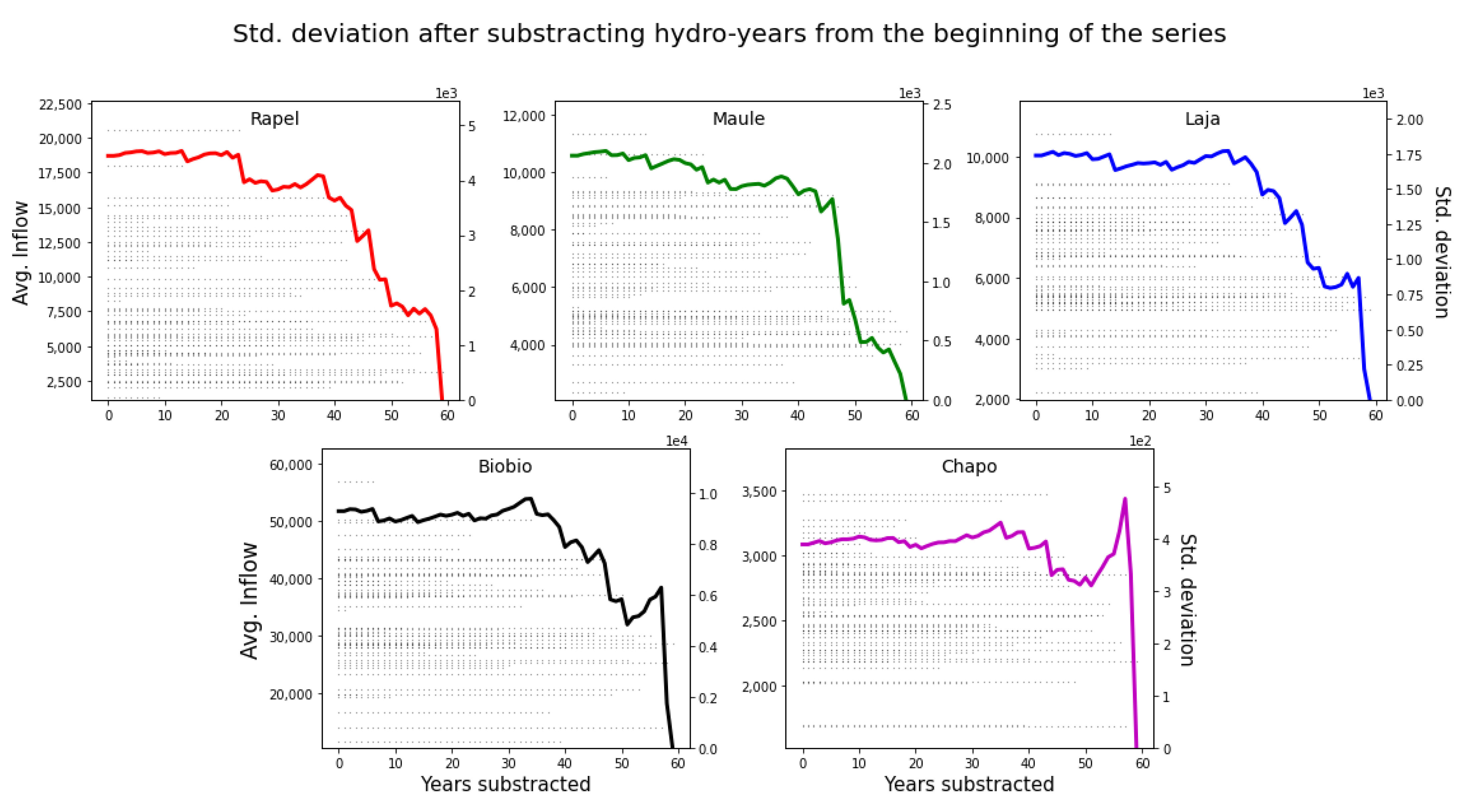
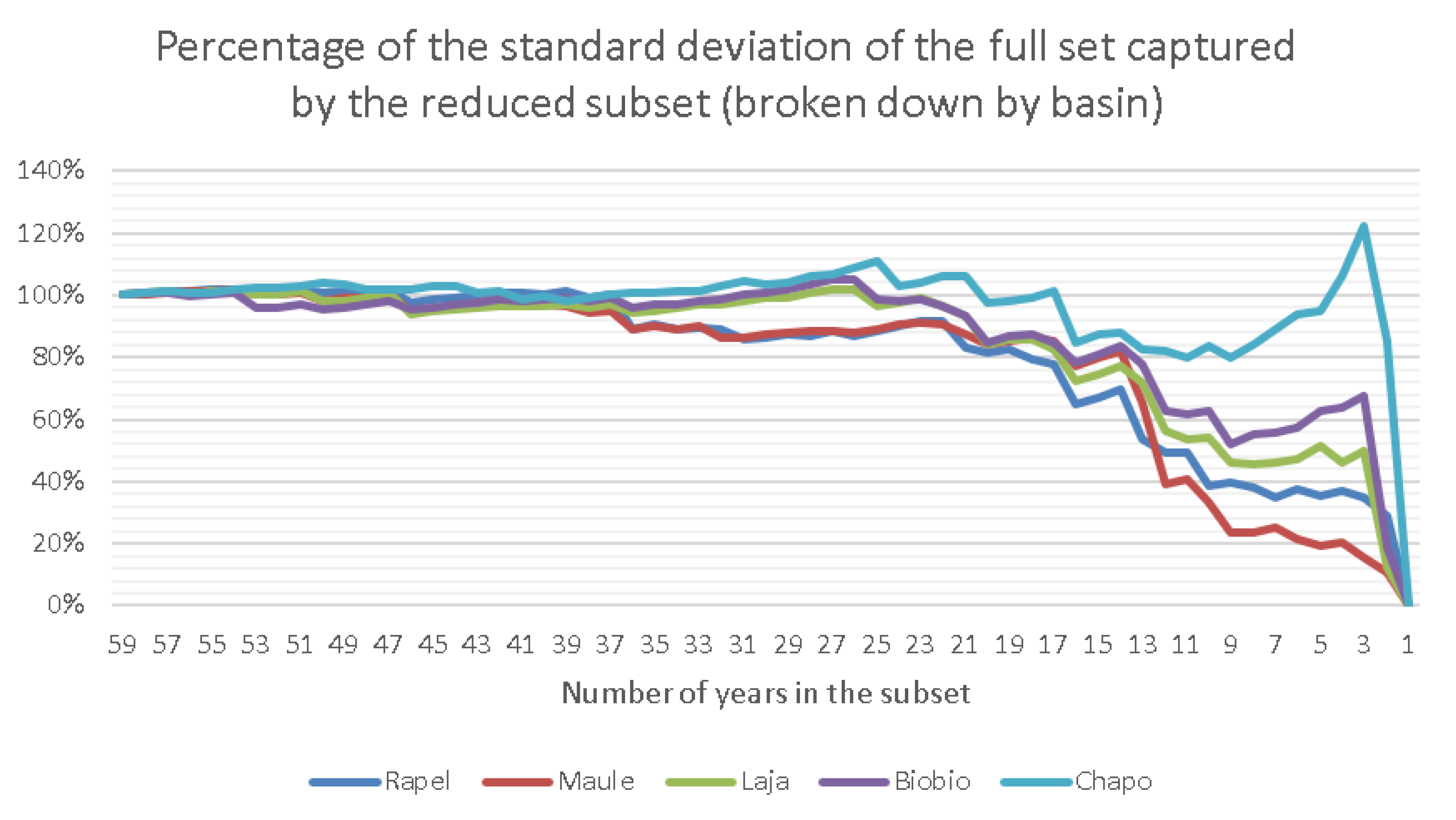
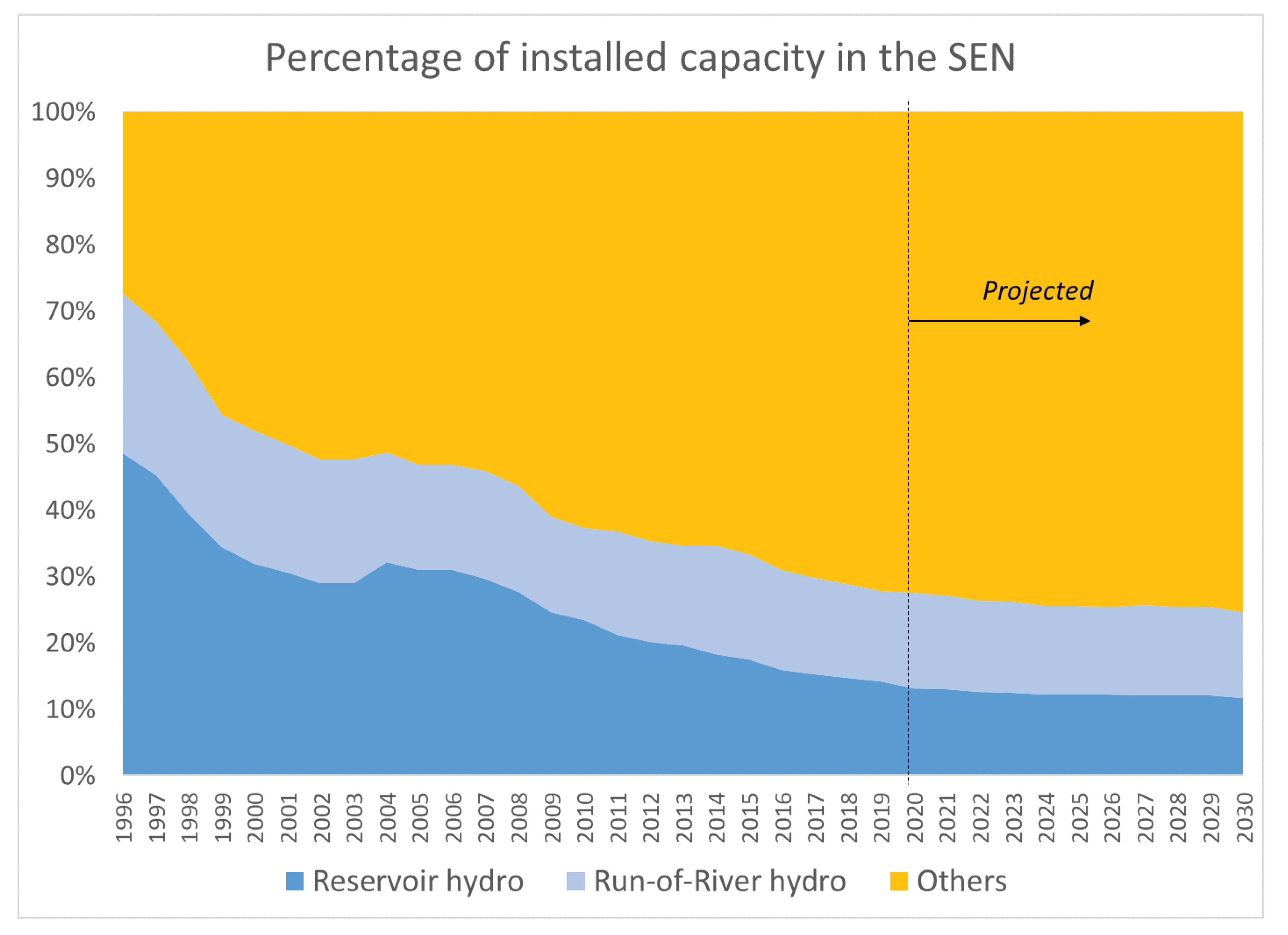
| Statistic | Business as Usual | After Step 1 | After Step 2 |
|---|---|---|---|
| (GWh) | Full Set | Reduced Subset | Extended Subset |
| of Hydro-Years | with 24 Hydro-Years | with 33 Hydro-Years | |
| Min | 16,524 | 16,524 | 16,524 |
| Max | 39,903 | 37,669 | 37,669 |
| Max–Min | 23,379 | 21,145 | 21,145 |
| Average | 30,295 | 28,291 | 27,261 |
| Std. dev. | 5717 | 5948 | 5436 |
| Q1 | 26,568 | 23,438 | 23,347 |
| Q2 (median) | 30,541 | 26,825 | 26,538 |
| Q3 | 34,521 | 33,570 | 30,674 |
| IQR | 7953 | 10,132 | 7327 |
Publisher’s Note: MDPI stays neutral with regard to jurisdictional claims in published maps and institutional affiliations. |
© 2021 by the authors. Licensee MDPI, Basel, Switzerland. This article is an open access article distributed under the terms and conditions of the Creative Commons Attribution (CC BY) license (http://creativecommons.org/licenses/by/4.0/).
Share and Cite
Gil, E.; Morales, Y.; Ochoa, T. Addressing the Effects of Climate Change on Modeling Future Hydroelectric Energy Production in Chile. Energies 2021, 14, 241. https://doi.org/10.3390/en14010241
Gil E, Morales Y, Ochoa T. Addressing the Effects of Climate Change on Modeling Future Hydroelectric Energy Production in Chile. Energies. 2021; 14(1):241. https://doi.org/10.3390/en14010241
Chicago/Turabian StyleGil, Esteban, Yerel Morales, and Tomás Ochoa. 2021. "Addressing the Effects of Climate Change on Modeling Future Hydroelectric Energy Production in Chile" Energies 14, no. 1: 241. https://doi.org/10.3390/en14010241
APA StyleGil, E., Morales, Y., & Ochoa, T. (2021). Addressing the Effects of Climate Change on Modeling Future Hydroelectric Energy Production in Chile. Energies, 14(1), 241. https://doi.org/10.3390/en14010241





